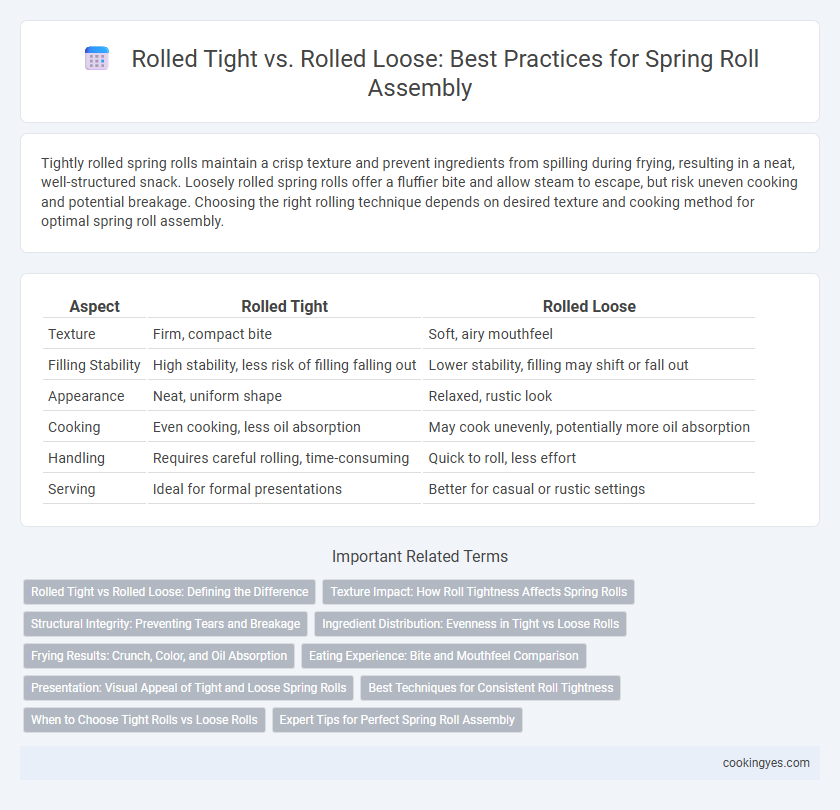Tightly rolled spring rolls maintain a crisp texture and prevent ingredients from spilling during frying, resulting in a neat, well-structured snack. Loosely rolled spring rolls offer a fluffier bite and allow steam to escape, but risk uneven cooking and potential breakage. Choosing the right rolling technique depends on desired texture and cooking method for optimal spring roll assembly.
Table of Comparison
| Aspect | Rolled Tight | Rolled Loose |
|---|---|---|
| Texture | Firm, compact bite | Soft, airy mouthfeel |
| Filling Stability | High stability, less risk of filling falling out | Lower stability, filling may shift or fall out |
| Appearance | Neat, uniform shape | Relaxed, rustic look |
| Cooking | Even cooking, less oil absorption | May cook unevenly, potentially more oil absorption |
| Handling | Requires careful rolling, time-consuming | Quick to roll, less effort |
| Serving | Ideal for formal presentations | Better for casual or rustic settings |
Rolled Tight vs Rolled Loose: Defining the Difference
Rolled tight spring rolls feature compact layers that ensure fillings stay secure, enhancing crispness during frying and preventing leakage. Rolled loose spring rolls have a more relaxed wrap, allowing for a lighter texture but increasing the risk of filling spilling out and less structural integrity. Choosing between rolled tight and rolled loose assembly depends on desired texture, cooking method, and presentation preferences in spring roll preparation.
Texture Impact: How Roll Tightness Affects Spring Rolls
Tightly rolled spring rolls create a firmer, crispier texture that holds fillings securely and prevents sogginess during frying. Loosely rolled spring rolls tend to have a delicate, lighter crunch with a softer bite, allowing the fillings to shift and blend flavors more readily. The roll tightness directly impacts the balance between crispy exterior and tender interior, influencing the overall eating experience.
Structural Integrity: Preventing Tears and Breakage
Rolled tight spring rolls ensure enhanced structural integrity by minimizing air pockets, which significantly reduces the risk of tears and breakage during cooking or handling. Loose rolling allows excess movement inside the wrapper, increasing vulnerability to cracks and compromising the roll's ability to hold fillings securely. Maintaining a firm yet gentle roll achieves optimal balance, preventing breakage while preserving the spring roll's crisp texture.
Ingredient Distribution: Evenness in Tight vs Loose Rolls
Tightly rolled spring rolls ensure uniform ingredient distribution, preventing fillings from shifting and maintaining consistent texture and flavor in each bite. Loose rolls often lead to uneven layering, causing some sections to be overly filled while others are sparse, affecting the overall eating experience. Consistent ingredient distribution in tight rolls enhances presentation and structural integrity, reducing the risk of tearing during frying or serving.
Frying Results: Crunch, Color, and Oil Absorption
Spring rolls rolled tight create a crispier texture with a uniform golden-brown color due to even frying and less oil absorption. Loose rolls tend to absorb more oil, resulting in a greasier texture and inconsistent browning. Properly tight rolling ensures a crunchier bite and a visually appealing, less oily spring roll.
Eating Experience: Bite and Mouthfeel Comparison
Rolled tight spring rolls offer a firmer bite and a compact mouthfeel that maintains the crispness of the wrapper while evenly containing the filling. Rolled loose spring rolls provide a lighter, airier texture, allowing for a more pronounced contrast between crunchy wrapper and tender interior but may feel less cohesive when eaten. The choice between tight and loose rolling directly impacts the balance of textures and the overall satisfaction of each bite.
Presentation: Visual Appeal of Tight and Loose Spring Rolls
Tightly rolled spring rolls present a sleek, compact shape that enhances visual appeal through uniform edges and minimal gaps, creating an inviting, professional look. Loosely rolled spring rolls offer a rustic, airy texture that reveals vibrant fillings and fresh ingredients, providing an enticing, colorful presentation. Choosing between tight and loose rolls depends on the desired aesthetic effect and how the spring rolls will be served or dipped.
Best Techniques for Consistent Roll Tightness
Achieving consistent roll tightness in spring roll assembly requires proper technique and attention to detail. Rolling tight ensures a compact, crisp texture and prevents the filling from falling out during frying or serving, while rolling loose may lead to soggy or uneven cooking. Best practices include evenly distributing filling, tucking ingredients firmly before rolling, and applying gentle but firm pressure to maintain uniform tightness without tearing the rice paper wrapper.
When to Choose Tight Rolls vs Loose Rolls
Tight spring rolls are ideal for frying as they maintain structural integrity and prevent fillings from spilling out during cooking, ensuring a crispy, evenly cooked exterior. Loose rolls suit fresh, uncooked spring rolls where a tender texture and airy bite highlight fresh ingredients, allowing for better sauce absorption. Choose tight rolls for deep-frying and loose rolls when serving fresh, making sure to match roll tightness to cooking method and desired texture.
Expert Tips for Perfect Spring Roll Assembly
Rolled tight spring rolls ensure a crisp texture and prevent fillings from falling out during frying or steaming, maintaining an appealing shape and even cooking. Rolled loose spring rolls may result in uneven cooking and a less sturdy wrapper, causing the filling to leak and diminishing overall presentation. Expert chefs recommend applying gentle but firm pressure when rolling to balance tightness, enhancing both texture and structural integrity.
Rolled tight vs Rolled loose for spring roll assembly Infographic

 cookingyes.com
cookingyes.com